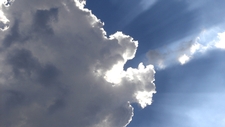Condensation/Precipitation

TEKS Objective
The student is expected to explore the processes in the water cycle, including evaporation, condensation, and precipitation, as connected to weather conditions.
Essential Understanding
The student knows that there are recognizable patterns in the natural world and among objects in the sky.
Science Background
The Water Cycle, Condensation: US Geological Survey (website) - Condensation is the process by which liquid water forms from water vapor in the air. Learn more about clouds and condensation, and their critical role in the water cycle at this informative link.
The Water Cycle, Precipitation: US Geological Survey (website) - Learn about the formation and shape of raindrops, precipitation patterns in different parts of the world, and precipitation size, velocity and volume.
What is the Difference between Evaporation and Condensation? American Geological Institute (website) - Detailed information about the differences between these two phases of the water cycle.
Signature Lesson
Weathering the Water Cycle, Condensation: Learn NC (website) - Students explore condensation as one phase of the water cycle, and begin to understand that the water cycle is a continuous process.
Weathering the Water Cycle, Precipitation: Learn NC (website) - Students explore precipitation as one of the three stages of the water cycle, and learn how it relates to the other stages.
- Supporting Lessons
- Extensions
- Assessment Ideas
- Literature Connections
- Related
TEKS - Additional Resources
Supporting Lessons
Making Clouds: Exploring Nature Educational Resource (website) - Students observe the formation of clouds in a bottle to investigate condensation, precipitation and the water cycle.
Making Clouds
Exploring Nature Educational Resource, www.exploringnature.org
Rain Making: Exploring Nature Educational Resource (website) - Students condense water from steam and create “rain.”
Rain Making
Exploring Nature Educational Resource, www.exploringnature.org
Elaboration Lessons and Extensions
Around We Go With the Water Cycle The Core Knowledge Foundation (PDF) - Use lessons 2 (page 4) and 4 (page 7) to teach students about evaporation and condensation.
Around We Go With the Water Cycle
The Core Knowledge Foundation, www.coreknowledge.org
Assessment Ideas
Instruct students, individually or in groups, to design and create a poster that shows examples of condensation and evaporation.
Literature Connections
Magic School Bus Wet All Over. Cole, Joanna (ISBN: 0590508334)
Clouds. Saunders Smith, Gail (ISBN: 1560657774)
The Cloud Book. De Paola, Tomie (ISBN: 0823405311)
Liquid to Gas and Back. Patten, J.M. (ISBN: 1559161299)
Cloudy With a Chance of Meatballs. Barrett, Judi (ISBN: 0689707495)
What Do You See in a Cloud? Fowler, Allan (ISBN: 0516202227)
Drip! Drop! How Water Gets to Your Tap. Seuling, Barbara (ISBN: 0-823-41459-0)
A Drop Around the World. Shaw-McKinney, Barbara (ISBN: 1-883-22072-6)
Water. Flanagan, Alice (ISBN: 0-7565-0038-9)
Water. Ditchfield, Christin; Jenner, Jan; and Vargus, Nanci R. (ISBN: 0-516-29369-9)
Water, Water Everywhere. Rauzon, Mark J. and Overbeck-Bix, Cynthia (ISBN: 0-871-56383-5)
Bringing the Rain to Kapiti Plain. Aardema, Verna (ISBN: 0-140-54616-2)
Water Dance. Locker, Thomas (ISBN: 0-152-16396-4)
The Water Cycle. Frost, Helen (ISBN: 0-7368-2314-X)
Additional Resources
Follow a Drop through the Water Cycle: US Geological Survey (website) - Students learn the water cycle by envisioning a drop of water as it moves from place to place, and through different states of matter.
Water Cycle: Exploring Earth (website) - Students observe a raindrop traveling through various points of the water cycle in this interactive animation.
Water Cycle
Exploring Earth, Houghton Mifflin Harcourt Publishing Company, www.classzone.com
The Water Cycle: KidZone (website) - Students learn about the phases of the water cycle, and understand that the Earth’s limited water supply has been cycling for billions of years.
TEKS Navigation
Grade 2
Need Assistance?
If you need help or have a question please use the links below to help resolve your problem.

Comments